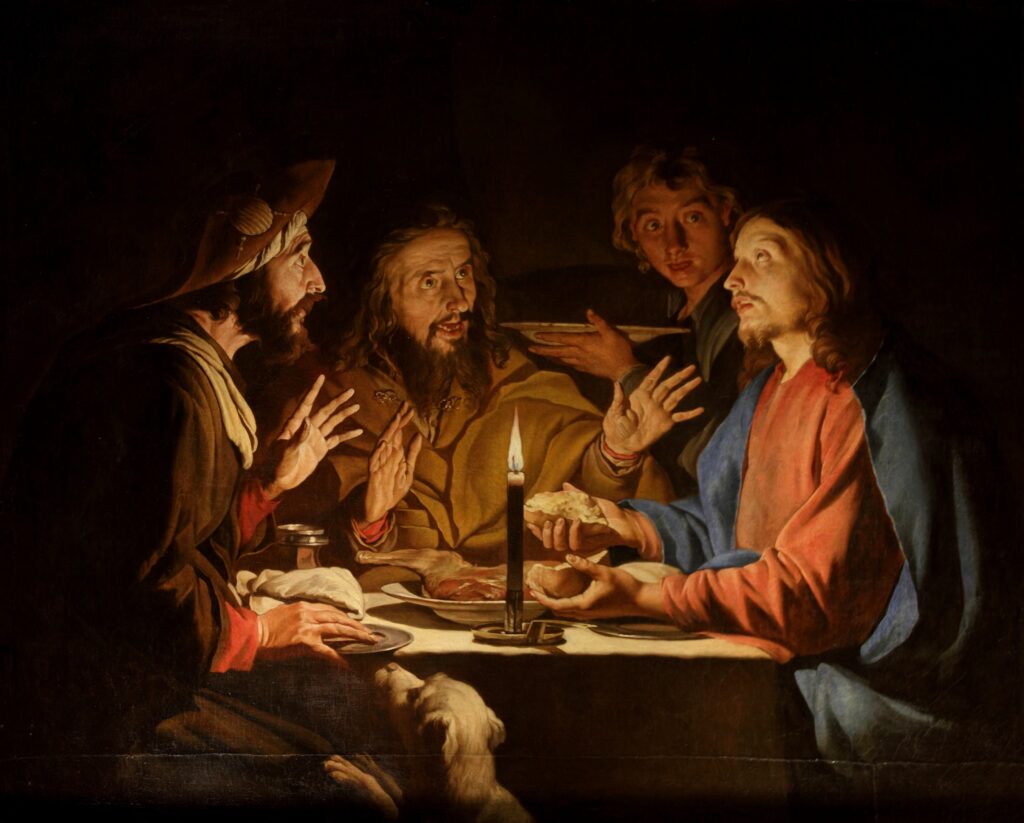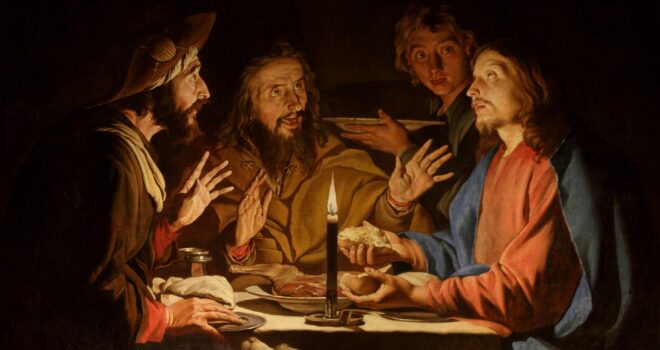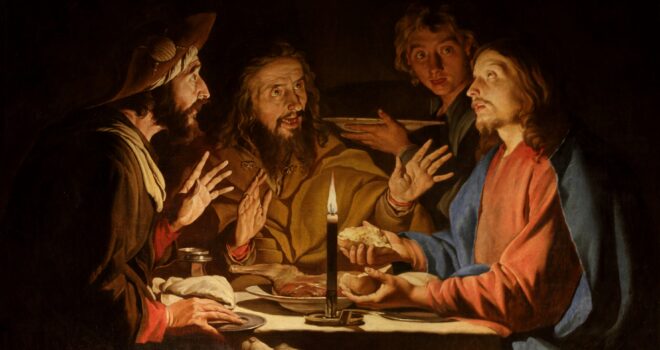Viewing and pondering sacred art, engaging in vizio divina, offers the faithful a great way to meditate more deeply on the life of Jesus Christ and the mystery of salvation. This series of articles will highlight several pieces of art related to the glorious Easter season, with specific attention to Scripture readings. Each of these pieces of art allows us to reflect on the astonishing realities of the resurrected life.
Each year, the Third Sunday of Easter allows the faithful to hear the biblical episode that recounts two disciples walking to Emmaus and experiencing a miraculous meal at their destination. Within the whole story, hearers get a glimpse into the conversation that took place between the two disciples and their mysterious Interlocutor. We also hear of their sorrow because “we were hoping that [Jesus] would be the one to redeem Israel” (Lk. 24:21). We hear of the greatest Bible study in history (cf. Lk. 24:27) and, finally, of the intimate meal that led to an amazing revelation. This journey-turned-pilgrimage is truly one of the great Easter episodes in the Gospel.
In the 1630s, Matthias Stom, a Dutch painter influenced by students of Caravaggio, painted several versions of Supper at Emmaus, depicting the miraculous meal in this biblical passage. Each of the versions has unique and memorable details, but this essay is focused version that is currently housed at the Museo Nacional Thyssen-Bornemisza in Madrid, on which Stom worked for more than half the decade. Its details make it similar to and distinct from Caravaggio and those influenced by the Renaissance master.

Here, Stom employs two techniques that Caravaggio used with great effect. First, Stom uses a dark background, which creates a deeply intimate moment for the viewer. It is as though this dinner table with these four figures is the only place in the world at this moment. Second, Stom employs the chiaroscuro technique that Caravaggio mastered, giving texture to the scene by the deep contrast of dark and light. The artist’s use of these two techniques reveals that great art stands in continuity with other great works and artists who have worked before.
The light for this painting’s chiaroscuro seems to be emitted from a single candle in the middle of the table. This candle causes viewers to recall the powerful words of the prologue of St. John’s Gospel: “The light shines in the darkness, and the darkness has not overcome it” (Jn. 1:5 ESV). This visual theme also has potential to remind the viewer of the Paschal candle at the Easter Vigil Mass, which brings the light of the Risen Christ into the darkened church. One who gazes at this painting might ask questions related to light: How has the Light of the World illuminated the dark, shadowy areas of my life? Has the Lord provided moments of light that have allowed me to know more about who He is and what He has planned for me?
This painting brings viewers directly into the moment when “their eyes were opened and they recognized him,” just before “he vanished from their sight” (Lk. 24:31). We see Jesus holding two halves of the small loaf of bread in His hands. This opens up a consideration of profound and glorious moments when we have received a deeper understanding about Jesus in the Eucharist. Has the Lord remained hidden from my sight for a time, perhaps during a very sad time, only to reveal Himself more fully later? How did I respond when He made that revelation?
The three men who are in this room with Jesus are uniquely instructive. First, the two men seated at the table with Jesus are Cleopas and the other unnamed disciple. In this version of the painting, the artist presents the two disciples as widely variant in age: one is quite a bit older and one is quite young. This detail depicts the reality of the Church, which is made up of people of so many life conditions. Am I able to recognize that every baptized person has something unique and special to contribute to the life of the Church, regardless of age or any other physical or social condition?
The third figure at the meal is an outsider, someone who was not part of the pilgrimage from Jerusalem and the conversation with the hidden Jesus. Perhaps he is a servant at the inn where they intended to lodge. In any case, the artist depicts him as looking on with great intrigue, even awe, in this moment. This simple detail causes the viewer to remember that there are many “outsiders” who know of Jesus; who long for the grace that He offers; and who have potential to be great evangelists. This detail also reminds us that it is up to us, the faithful, to reach out and bring these people into the fold of the One, Holy, Catholic, and Apostolic Church. Have I been part of the apostolic mission of the Church, reaching out to provide other with an opportunity to come closer to Jesus?
The postures of both seated disciples, and the looks on their faces, are also significant for reflection. As the older disciple realizes the identity of this Mysterious Guest, he reaches out to touch the One who has revealed Himself. He looks at Jesus in a way that says, “I want a deeper relationship with Jesus, my Lord, and I want to understand more.” Gazing at this painting might cause a viewer to ponder: Have I longed for deeper intimacy with Jesus? Have I reached out to try to touch him through Eucharistic Adoration, the study of Sacred Scripture, or even Ministry to the Sick?
The young disciple at the left of the scene is aghast as he realizes the miracle that has just occurred, and Jesus’ identity. At this very moment, he begins to stand up. This is the artist’s way of depicting his transition from being downcast to becoming an apostle and evangelist. Immediately, both disciples “set out at once” for a return trip to Jerusalem to share what they had experienced. When I relate to Jesus in the Eucharist, either at Mass or Adoration, am I impelled to mission? To whom do I go to tell the Good News I have encountered? Do I realize that this is supposed to be a reality after every Mass and period of Adoration?
As we reflect on Stom’s painting, and as we move through the Easter season, let’s remember these lessons that Our Blessed Lord desires to teach us in our own time and place. Let’s reach out to Jesus and ask Him to draw us more deeply into His life and love, especially through the Breaking of the Bread. Let’s be ready to go out on mission, proclaiming what we have seen, especially to those who are intrigued to hear the Gospel. In these ways, we will become the disciples and apostles that the Lord intends us to be.
✠












